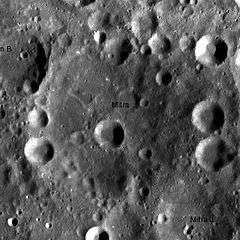Mitra (crater)
Mitra is a lunar impact crater that is attached to the western outer rim of the larger crater Mach, on the far side of the Moon. Just to the west of Mitra is Bredikhin, and to the south-southeast lies Henyey. It is named after Sisir Kumar Mitra, who was an Indian physicist and Padma Bhushan award recipient known for his pioneering work in the field of ionosphere and radiophysics.[1]
 LRO WAC image | |
| Coordinates | 18.0°N 154.7°W |
|---|---|
| Diameter | 92 km |
| Depth | Unknown |
| Colongitude | 155° at sunrise |
| Eponym | Sisir K. Mitra |
This is a heavily eroded formation with an outer rim that has been damaged by subsequent impacts. Attached to the exterior along the southeast is the satellite crater Mitra J. A number of smaller impacts lie along the rim edge, and very little of the original rim remains intact. Within the interior, a smaller crater occupies the southwestern part of the floor, and a small, cup-shaped crater lies across the northeast rim of this formation and very close to the midpoint of Mitra. The remaining floor is marked only by a few small and tiny craterlets.
Mitra lies within the Dirichlet–Jackson Basin.
Satellite craters
By convention these features are identified on lunar maps by placing the letter on the side of the crater midpoint that is closest to Mitra.
| Mitra | Latitude | Longitude | Diameter |
|---|---|---|---|
| A | 20.8° N | 154.1° W | 46 km |
| J | 15.9° N | 153.2° W | 46 km |
| Y | 21.5° N | 155.2° W | 26 km |
See also
References
- Andersson, L. E.; Whitaker, E. A. (1982). NASA Catalogue of Lunar Nomenclature. NASA RP-1097.CS1 maint: ref=harv (link)
- Blue, Jennifer (July 25, 2007). "Gazetteer of Planetary Nomenclature". USGS. Retrieved 2007-08-05.CS1 maint: ref=harv (link)
- Bussey, B.; Spudis, P. (2004). The Clementine Atlas of the Moon. New York: Cambridge University Press. ISBN 978-0-521-81528-4.CS1 maint: ref=harv (link)
- Cocks, Elijah E.; Cocks, Josiah C. (1995). Who's Who on the Moon: A Biographical Dictionary of Lunar Nomenclature. Tudor Publishers. ISBN 978-0-936389-27-1.CS1 maint: ref=harv (link)
- McDowell, Jonathan (July 15, 2007). "Lunar Nomenclature". Jonathan's Space Report. Retrieved 2007-10-24.CS1 maint: ref=harv (link)
- Menzel, D. H.; Minnaert, M.; Levin, B.; Dollfus, A.; Bell, B. (1971). "Report on Lunar Nomenclature by the Working Group of Commission 17 of the IAU". Space Science Reviews. 12 (2): 136–186. Bibcode:1971SSRv...12..136M. doi:10.1007/BF00171763.CS1 maint: ref=harv (link)
- Moore, Patrick (2001). On the Moon. Sterling Publishing Co. ISBN 978-0-304-35469-6.CS1 maint: ref=harv (link)
- Price, Fred W. (1988). The Moon Observer's Handbook. Cambridge University Press. ISBN 978-0-521-33500-3.CS1 maint: ref=harv (link)
- Rükl, Antonín (1990). Atlas of the Moon. Kalmbach Books. ISBN 978-0-913135-17-4.CS1 maint: ref=harv (link)
- Webb, Rev. T. W. (1962). Celestial Objects for Common Telescopes (6th revised ed.). Dover. ISBN 978-0-486-20917-3.CS1 maint: ref=harv (link)
- Whitaker, Ewen A. (1999). Mapping and Naming the Moon. Cambridge University Press. ISBN 978-0-521-62248-6.CS1 maint: ref=harv (link)
- Wlasuk, Peter T. (2000). Observing the Moon. Springer. ISBN 978-1-85233-193-1.CS1 maint: ref=harv (link)
- "ISRO releases fresh set of photos of moon craters". The Economic Times. 26 August 2019.